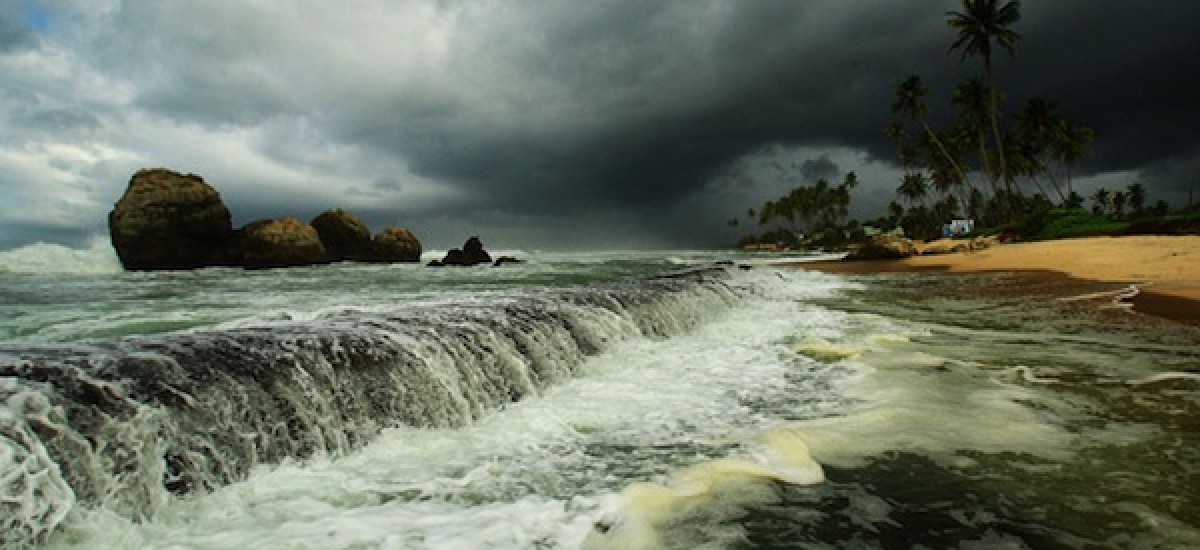Photo courtesy The Telegraph
The New Zealand cricketers should not be surprised that their matches are being rained on. The following is from an article titled “The Language of Climate in Sri Lanka” (Daily News 28/04/09), also in the Island (12/05/2007)
“In an article published a few years ago (Daily News, Thursday 4th December 2003) we found the schedules and venues of the Test cricket matches for a decade were out of sync with the climate. Most of our test matches had been scheduled at the start of the Maha season – a time to make a good muddy field.”
I recently met the author of this article, Lareef Zubair, who explained that a large part of the problem is the public perception of the word monsoon. The word is redolent of darkening skies, torrential rain and tropical lushness. I myself have often wondered why there was no classic monsoon rain during the so-called monsoon, and why the heaviest rain always seemed to be referred to as “intermonsoonal”. It is always tempting to put such apparent discrepancies down to increasingly unpredictable global weather patterns. After all, Sri Lanka has had its share of extreme weather events, including cyclones and droughts in recent years.
But as Lareef explained, the association of the word monsoon with rain is misleading, especially in the Sri Lankan context. The word derives from the Arabic mawsim, which simply refers to a season, as defined by the prevailing wind direction. In Sri Lanka, there are two such seasons: the South-West monsoon (May to September), and the North-East monsoon (December to February). Inbetween are two periods referred to as the intermonsoons: First Intermonsoon (March/April) and Second Intermonsoon (October/November). And it is the latter, as the graph in the Daily News article shows, which brings the heaviest rains throughout the island, often reminiscent of the stereotypical image of a tropical monsoon.
According to Lareef, it is the British colonials who are to be blamed for appropriating the word monsoon and associating it exclusively with heavy rains. This is because in much of India the South-West monsoon does bring heavy rainfall with it. But this is not the case in Sri Lanka. The South-West monsoon is a period of unsettled weather, especially in the wet zone in the south-west: grey skies, rough seas and yes, some rain – an off-season for tourists and fishermen, many of whom migrate from their homes on the west coast to temporary settlements on the east coast for that part of the year. But the peak rainfall is during the Second Intermonsoon.
Farmers are well aware of the prevailing seasons. The traditional agricultural seasons are Maha (October to March) and Yala (April to September), each season starting with a period of heavy rainfall, and ending with dry weather for the harvest. Naturally, the exact timing of planting and harvesting the crop will vary from place to place, but broadly speaking the two seasons are the same islandwide. Maha is the main season; in drier areas, cultivation during the Yala season is dependent on irrigation from tanks.
False perceptions about the meaning of the word monsoon can be found everywhere, from fiction to government websites and tourist guidebooks. This, for example, from the eminent Professor JB Disanayaka in his recently published Encyclopaedia of Sinhala Language and Culture: “Rains come twice a year: South-west monsoons from May to September and North-east monsoons from December to February.”
And misconceptions about the monsoon can affect many activities, not least tourism. The example quoted in the Daily News article is the scheduling of international cricket matches. Deliberately avoiding the monsoon months, they have too often been scheduled at the time of the heaviest intermonsoonal rain, resulting in abandoned matches, disappointed fans, financial losses, and no doubt a few anomalous results determined by Duckworth-Lewis.


